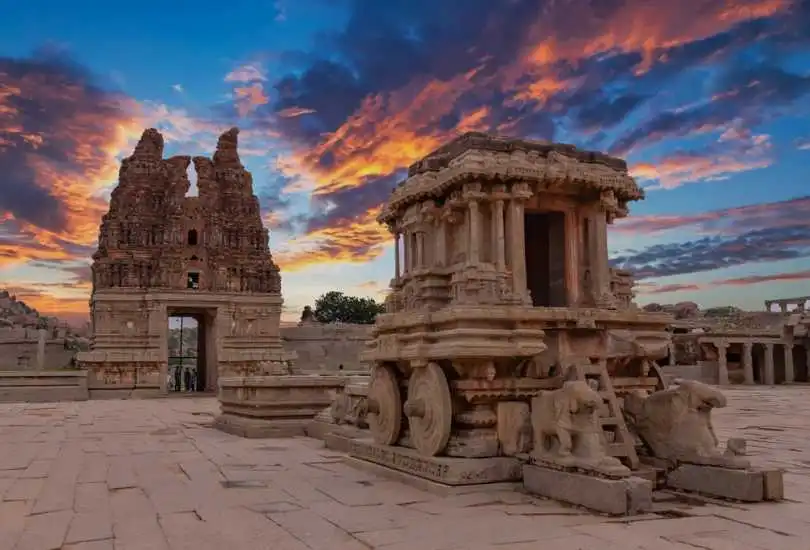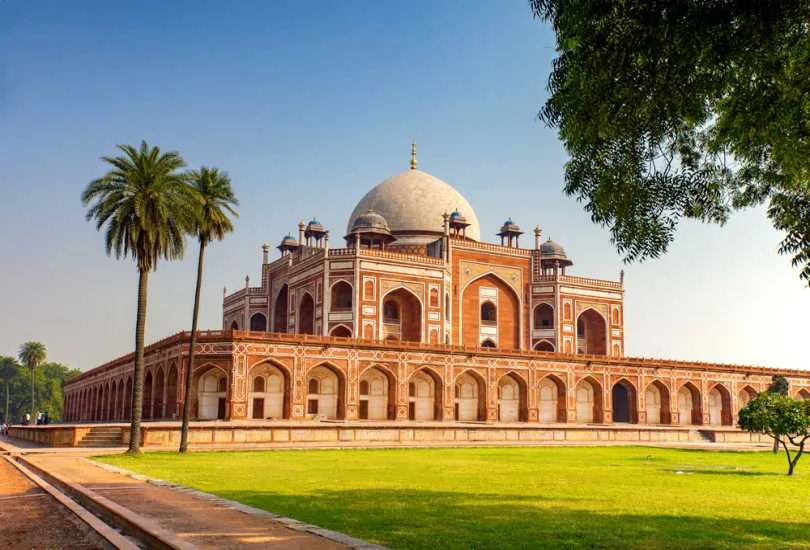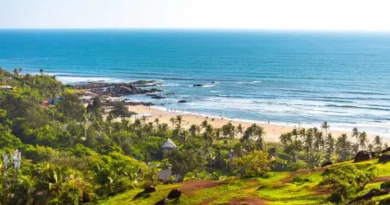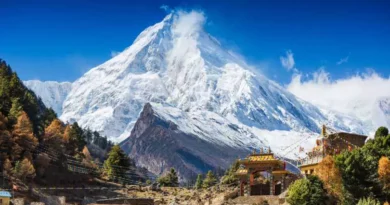20 Historical Places to Visit in India
India has a rich cultural legacy and history, and it is home to numerous historical sites that provide insight into the country’s magnificent past. From old forts and palaces to ornate temples and ancient city ruins, India provides a broad assortment of historical sites worth seeing.
These locations demonstrate the country’s architectural prowess and provide insight into its cultural, social, and religious values.
One of India’s most famous historic places is the Taj Mahal, located in Agra. The Taj Mahal is a love symbol and one of the World’s Seven Wonders. It was created in remembrance of Mughal emperor Shah Jahan’s adored wife, Mumtaz Mahal. The Taj Mahal is a Mughal architectural marvel famed for its elaborate carvings, delicate marble inlay work, and lovely gardens.
The Red Fort in Delhi is another well-known historical site in India. It was erected in the 17th century by Mughal emperor Shah Jahan and symbolised Mughal power and magnificence. The Red Fort is famous for its exquisite architecture, including the Diwan-i-Khas and Diwan-i-Am, used for public and private audiences.
Another must-see historical places in India is the ancient city of Hampi in Karnataka. It was the Vijayanagara Empire’s capital and is now a UNESCO World Heritage Site. Visitors may explore historic temples, regal structures, and magnificent gateways at Hampi, showcasing the Vijayanagara Empire’s architectural magnificence.
The Ajanta and Ellora Caves in Maharashtra are also famous historical sites in India. These caves, carved out of rock around the second century BCE, are famous for their beautiful sculptures and murals. The Ajanta Caves are a Buddhist monument, whilst the Ellora Caves are a synthesis of Hindu, Buddhist, and Jain ideas.
Other well-known historical sites in India include Madhya Pradesh’s Khajuraho Temples, Rajasthan’s Amer Fort, Odisha’s Konark Sun Temple, and Tamil Nadu’s Meenakshi Temple.
Historical sites in India provide an intriguing peek into the country’s past and are a monument to the country’s rich cultural legacy. From old forts and palaces to ornate temples and ancient city ruins, India provides a broad assortment of historical sites worth seeing.
Whether you are a history buff or simply appreciate beautiful architecture, India’s historical sites will leave an indelible impression.
Table of Contents
- List of 20 Historical Places to Visit in India
- 1- Taj Mahal, Agra:
- 2- Red Fort, Delhi:
- 3- Hampi, Karnataka:
- 4- Ajanta and Ellora Caves, Maharashtra:
- 5- Khajuraho Temples, Madhya Pradesh:
- 6- Amer Fort, Rajasthan:
- 7- Konark Sun Temple, Odisha:
- 8- Meenakshi Temple, Tamil Nadu:
- 9- Fatehpur Sikri, Uttar Pradesh:
- 10- Qutub Minar, Delhi:
- 11- Mehrangarh Fort, Rajasthan:
- 12- Sanchi Stupa, Madhya Pradesh:
- 13- Brihadeeswarar Temple, Tamil Nadu:
- 14- Victoria Memorial, Kolkata:
- 15- Charminar, Hyderabad:
- 16- Mahabalipuram, Tamil Nadu:
- 17- Humayun’s Tomb, Delhi:
- 18- Sarnath, Uttar Pradesh:
- 19- Gwalior Fort, Madhya Pradesh:
- 20- Chittorgarh Fort, Rajasthan:
List of 20 Historical Places to Visit in India
1- Taj Mahal, Agra:

The Taj Mahal is one of India’s most iconic and well-known historical sites. It lies in the northern state of Uttar Pradesh, in Agra. The Taj Mahal was erected in remembrance of Mughal emperor Shah Jahan’s adored wife, Mumtaz Mahal. It symbolises love and is considered one of the World’s Seven Wonders.
The Taj Mahal’s construction began in 1632 and took over 20 years. The white marble monument is embellished with elaborate carvings, fine marble inlay work, and lovely gardens. Four minarets encircle the Taj Mahal’s central dome, each standing over 40 meters tall. A vast reflecting pool surrounds the monument, adding to its magnificence.
The Taj Mahal is a work of art of Mughal architecture and a testimony to the artisans and craftsmen who created it. The monument’s exquisite carvings and precise inlay work on the monument demonstrate the Mughal era’s creative skill. The monument’s design contains aspects of both Islamic and Hindu architecture, making it a symbol of religious harmony.
The Taj Mahal is open daily except Fridays, and it is best to go early in the morning or late in the afternoon to avoid crowds. Visitors can stroll through the monument’s gorgeous gardens, view the elaborate carvings and inlay work, and learn about the intriguing Mughal era’s history.
2- Red Fort, Delhi:

The Red Fort in Delhi is one of India’s most prominent historical sites in India and is located in the middle of the city. It was erected in the 17th century by Mughal emperor Shah Jahan and served as the Mughal monarch’s home for about 200 years. The Red Fort is a UNESCO World Heritage Site and a symbol of Mughal power and majesty.
The Red Fort is famous for its exquisite architecture, including the Diwan-i-Khas and Diwan-i-Am, used for public and private audiences.
The fort is constructed of red sandstone with beautiful carvings and marble inlay work. It also boasts various lovely gardens and courtyards, notably the well-known Nahr-i-Behisht (Paradise Stream) garden.
The Red Fort is also the location of India’s Independence Day celebrations on August 15th each year. The Indian Prime Minister hoists the national flag and delivers a speech from the fort’s walls.
Visitors can visit the Red Fort’s different buildings and gardens, appreciate the elaborate carvings and inlay work, and learn about Mughal history. The fort is open daily except Mondays, and it is best to come early in the morning or late in the afternoon to avoid crowds. The fort hosts a music and light performance in the evenings highlighting its history and architecture.
3- Hampi, Karnataka:

Hampi is a UNESCO World Heritage Site in the southern Indian state of Karnataka. In the 14th century, it was the capital of the Vijayanagara Empire and is now a renowned tourist attraction. Hampi is well-known for its rich history, spectacular architecture, and breathtaking scenery.
The Virupaksha Temple, the Vittala Temple, and the Hazara Rama Temple are among the historic temples and monuments in Hampi. The Virupaksha Temple, dedicated to Lord Shiva, is one of Hampi’s most important temples. The temple features a high gopuram (entry tower) and elaborate carvings demonstrating the Vijayanagara Empire’s architectural ability.
Other historical monuments in Hampi include the Queen’s Bath, the Lotus Mahal, the Elephant Stables, and the temples. The Queen’s Bath is a stunning, opulent bathhouse used by the Vijayanagara Empire’s royal women.
The Lotus Mahal is a magnificent palace with a distinctive Hindu and Islamic design blend. The Elephant Stables is a series of domed chambers that housed the royal elephants.
Hampi is also noted for its stunning scenery, which includes rolling hills, boulder-strewn terrain, and lush green woods. The Tungabhadra River runs through the centre of Hampi, creating a beautiful backdrop for the historic structures.
4- Ajanta and Ellora Caves, Maharashtra:

The Ajanta and Ellora Caves are UNESCO World Heritage Sites in the Indian state of Maharashtra. The caves are famous for their exquisite murals, sculptures, and stunning rock-cut architecture.
The Ajanta Caves are a collection of 30 rock-cut Buddhist caves constructed between the 2nd and 6th centuries BC. The caverns are famous for their stunning murals and sculptures depicting episodes from Buddha’s and other Buddhist deities’ lives. The Ajanta Caves are regarded as some of the best examples of Indian rock-cut architecture and a tribute to ancient India’s artistic prowess.
The Ellora Caves, on the other hand, is a collection of 34 rock-cut caves constructed between the sixth and tenth centuries AD. The caverns are recognized for their stunning sculptures and complex carvings and feature a unique blend of Buddhist, Hindu, and Jain architecture.
The Kailash Temple, dedicated to Lord Shiva, is the most famous Ellora complex cave and one of the world’s largest monolithic buildings.
5- Khajuraho Temples, Madhya Pradesh:

The Khajuraho Temples are a collection of Hindu and Jain temples in Khajuraho, Madhya Pradesh. The temples were constructed during the 10th and 12th century AD and are recognized for their exquisite architecture and sculptures.
The Khajuraho Temples are regarded as some of the best examples of Indian temple construction and a tribute to ancient India’s artistic prowess. The temples are made of sandstone and have beautiful carvings and sculptures. There are three groups of temples: the Western Group, the Eastern Group, and the Southern Group.
The Western Group, which comprises the Kandariya Mahadeva Temple, the Chausath Yogini Temple, and the Matangeshwar Temple, is the most well-known group of temples in Khajuraho. The Kandariya Mahadeva Temple, dedicated to Lord Shiva, is Khajuraho’s largest and most magnificent temple.
The Eastern Group of Temples in Khajuraho is recognized for its tranquil and peaceful ambience and contains the Jain temples. The Southern set of Temples is Khajuraho’s least frequented set of temples, yet it is still worth a visit for those who want to see the magnificence of Khajuraho’s temple architecture.
6- Amer Fort, Rajasthan:

Amer Fort is a UNESCO World Heritage Site in Rajasthan, India’s westernmost state. The fort is situated on a hilltop with a panoramic view of Jaipur. Raja Man Singh erected it in the 16th century, and it is noted for its gorgeous architecture and beautiful surroundings.
The fort is made of red sandstone and marble, and its architecture combines Hindu and Islamic elements. The fort’s courtyards, palaces, and temples include the Sheesh Mahal (Palace of Mirrors), the Diwan-i-Khas (Hall of Private Audience), and the Jai Mandir (Hall of Victory).
The Sheesh Mahal, one of Amer Fort’s most famous palaces, is known for its beautiful mirror artistry. Thousands of tiny mirrors decorate the palace’s walls and ceilings, reflecting light and creating a brilliant effect.
The Diwan-i-Khas is another prominent palace in Amer Fort that the royal family used for secret audiences. The Jai Mandir is a magnificent palace with gorgeous marble carvings and elaborate embellishments.
Amer Fort is also well-known for its lovely surroundings, which include the Maota Lake and the Aravalli Hills. Visitors can ride elephants up to the fort or walk up the hill to enjoy the breathtaking views of Jaipur and its surroundings.
7- Konark Sun Temple, Odisha:

The Konark Sun Temple is a UNESCO World Heritage Site in the town of Konark in the Indian state of Odisha. The temple was established in the 13th century by King Narasimhadeva I of the Eastern Ganga Dynasty and is dedicated to the Hindu sun god Surya.
The temple is well-known for its beautiful architecture, which includes elaborate carvings and sculptures depicting many mythological themes and events. The temple is shaped like a chariot, with twelve pairs of wheels and seven horses sculpted from stone.
Other architectural highlights of the temple are the Jagmohana (porch), Natamandira (dance hall), and Bhogamandapa (feast hall). The Jagmohan is famous for its magnificent carvings of singers, dancers, and animals, while the Natamandira depicts diverse dance forms in stunning detail.
The astronomical significance of the Konark Sun Temple is also well-known. The Nata Mandira is built so that the first rays of the sun fall on it every morning, illuminating the sculptures inside.
8- Meenakshi Temple, Tamil Nadu:

The Meenakshi Temple is a Hindu temple in Madurai, Tamil Nadu, in southern India. The temple is devoted to the Hindu goddess Meenakshi, who is thought to be an incarnation of Parvati.
The temple is well-known for its beautiful architecture, which includes elaborate carvings and sculptures depicting many mythological themes and events. The temple features four main entrances, each beautifully embellished with sculptures and carvings.
Other architectural aspects of the temple include the main sanctum sanctorum, which holds the idol of the goddess Meenakshi, and the thousand-pillared hall, famed for its magnificent sculptures and carvings.
The Meenakshi Thirukalyanam, a ten-day celebration commemorating the marriage of the goddess Meenakshi and her husband, Lord Shiva, is one of the most notable festivals celebrated at the Meenakshi Temple. Thousands of devotees from India attend the event, famed for its colorful processions, music, and dance.
9- Fatehpur Sikri, Uttar Pradesh:

The Agra district of Uttar Pradesh is home to the fortified city of Fatehpur Sikri. It was the capital of the Mughal Empire for around 14 years and was built in the 16th century by Mughal emperor Akbar. Beautiful buildings in Mughal, Persian, and Indian styles have made this city famous.
The Buland Darwaza, a colossal entrance; the Diwan-i-Khas, a hall of private audience; and the Panch Mahal, a five-story palace, are the most well-known structures in Fatehpur Sikri.
The Tomb of Salim Chishti, a respected Sufi saint, the Jodha Bai Palace, built for Akbar’s Hindu bride, and the Jama Masjid, the largest mosque in India, are also located in Fatehpur Sikri.
10- Qutub Minar, Delhi:

The Qutub Minar is a towering minaret located in the Mehrauli area of Delhi. Qutub-ud-din Aibak erected this 73-meter-tall minaret in the 12th century, making it one of the world’s highest—the red sandstone and marble minor feature elaborate carvings and inscriptions.
The Qutub Complex, of which the Qutub Minar is a part, is listed as a UNESCO World Heritage Site along with the Iron Pillar of Delhi, the Alai Darwaza, and the Quwwat-ul-Islam Mosque. The Qutub Minar and its surrounding structures are a testament to Delhi’s rich history and architectural legacy.
11- Mehrangarh Fort, Rajasthan:

The Mehrangarh Fort in Jodhpur, Rajasthan, is an impressive structure. Rao Jodha constructed one of India’s greatest forts in the 15th century. The stronghold is guarded by massive walls and gates and built atop a steep hill. The Mehrangarh Fort houses several palaces, courtyards, and temples, each with its unique architectural style.
The Sheesh Mahal, a palace with elaborate glasswork; the Phool Mahal, a palace with artistic carvings and paintings; and the Chamunda Mataji Temple, a Hindu temple devoted to the goddess Chamunda, are some of the most prominent structures within the fort. Anyone with even a passing interest in Rajasthani culture and history should make the trip to the Mehrangarh Fort.
12- Sanchi Stupa, Madhya Pradesh:

The Sanchi Stupa is an essential Buddhist structure in the Indian state of Madhya Pradesh. One of India’s oldest and best-preserved stupas, it dates back to the third century BCE.
The stupa is a brick tower with a white plaster exterior that takes the shape of a hemisphere. Human and animal figurines and scenes from Buddha’s life are carved into its ornate decoration.
There are many additional Buddhist buildings, such as temples, monasteries, and pillars, in the area surrounding the Sanchi Stupa. The stupa and its accompanying buildings have been designated as a UNESCO World Heritage Site because of their significance to India’s Buddhist history.
13- Brihadeeswarar Temple, Tamil Nadu:

Thanjavur, Tamil Nadu, is home to the Brihadeeswarar Temple, commonly known as the Big Temple. Among India’s best specimens of Dravidian architecture, it was commissioned by Chola King Rajaraja I and constructed in the 11th century.
Dedicated to the Hindu god Shiva, this temple complex is home to a vimana (or tower) that stands over 60 meters in height. The enormous Kalash or finial atop the vimana weighs more than 80 tonnes.
The temple also features elaborate carvings and sculptures, including over 1000 figures of dancing Nataraja, a form of Lord Shiva. The Brihadeeswarar Temple is a UNESCO World Heritage Site and attracts visitors from all over the world.
14- Victoria Memorial, Kolkata:

The Victoria Memorial in Kolkata, West Bengal, is a massive marble structure. It was constructed in the early 20th century to memorialize Queen Victoria. Now, it houses a museum devoted to the history of British rule in Kolkata and the rest of India.
The memorial comprises a massive central dome, multiple galleries, and a museum-quality collection of colonial-era paintings, sculptures, and artifacts. The grounds surrounding the monument are also frequently visited by guests. Anyone interested in India’s colonial past should visit the Victoria Memorial, one of Kolkata’s most visited landmarks.
15- Charminar, Hyderabad:

The Charminar is a monument and mosque located in Hyderabad, Telangana. Quli Qutb Shah constructed it in the latter half of the 16th century, and it has since become an iconic structure in Hyderabad. The monument has a central dome and four minarets, each over 20 meters tall.
Elaborate carvings and ornamentation complement the building’s granite and limestone construction materials. A lively market district specializing in jewelry, textiles, and street food can be found around the Charminar.
Visitors from all over the world go to see the monument because it serves as a symbol of Hyderabad’s illustrious cultural history.
16- Mahabalipuram, Tamil Nadu:

The village of Mahabalipuram, in the Indian state of Tamil Nadu, is famous for the ancient temples and sculptures carved out of the rock. During the Pallava dynasty, in the 7th and 8th centuries, the town flourished as a port, and it was during this time, many of the temples and sculptures were erected.
The Shore Temple on the beach dates back to the 8th century and is the most well-known landmark in Mahabalipuram.
The Arjuna’s Penance, a gigantic bas-relief sculpture depicting episodes from the Mahabharata, and the Pancha Rathas, a set of five monolithic temples, are both must-sees.
As a UNESCO World Heritage Site, Mahabalipuram attracts many visitors curious about ancient Indian culture and art.
17- Humayun’s Tomb, Delhi:

Humayun’s Tomb is a Mughal-era mausoleum located in the Nizamuddin East area of Delhi. Haji Begum, the wife of the Mughal emperor Humayun, commissioned its construction in the middle of the 16th century.
The mausoleum is a fine example of Mughal architecture with its red sandstone and white marble construction, elaborate carvings, and beautiful Persian-style gardens. The tomb’s central dome is encircled by smaller domes, arches, and chhatris (pavilions).
The Taj Mahal, which was constructed later, is thought to have been influenced by the tomb’s design. Several other members of the Mughal royal family are also buried in the tomb. It has become a major tourist destination and World Heritage Site recognized by UNESCO.
18- Sarnath, Uttar Pradesh:

The little town of Sarnath in the Indian state of Uttar Pradesh is famous for its many Buddhist temples and ruins. According to legend, this is where Gautama Buddha delivered his first sermon after realizing the truth.
The town is home to various historical sites, notably the Dhamek Stupa, built over the site where Buddha once delivered his speech. The stupa is a huge, elaborately decorated building composed of brick and stone.
Sarnath is home to many temples, monasteries, and stupas, many of which were built in the third century BCE. The village is a UNESCO World Heritage Site and a significant destination for Buddhists worldwide.
19- Gwalior Fort, Madhya Pradesh:

The city of Gwalior in the Indian state of Madhya Pradesh is home to the vast fort known as Gwalior Fort. The Tomar dynasty established it in the eighth century; subsequent dynasties included the Mughals and the Scindias.
The fort is home to various palaces, temples, and gates, such as the Man Mandir Palace, the Teli Ka Mandir, and the Gujari Mahal. The sandstone walls of the fort reach heights of up to 35 meters.
Also located within the fort is the Jaiwan Cannon, the giant mobile cannon in the world. The fort’s impressive architecture and rich history have made it a popular destination for visitors.
20- Chittorgarh Fort, Rajasthan:

Chittorgarh in Rajasthan is home to the gigantic fort known as Chittorgarh Fort. Several dynasties, including the Rajputs and the Mughals, have held power there since the Mauryas founded it in the seventh century.
The Rana Kumbha Palace, the Vijay Stambh, and the Kirti Stambh are just a few of the palaces, temples, and gates within the fort. The Gaumukh Reservoir and the Padmini Palace Lake are two of the most stunning features of the fort.
Over the centuries, the fort has been the site of numerous battles and sieges, most notably the famous Siege of Chittorgarh in 1568. Tourists go there now to marvel at its historic grandeur and architectural splendor.




